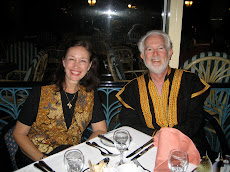"Vesuvio" can be seen looming in the distance (in the beautiful panoramic view below from Wikipedia), always ready to do it again.

 |
| Food stalls where food could be kept hot |
Beautiful frescoes adorn the walls. Their colors are original and not re-touched.

This is the mosaic tile floor of a heated-pool or spa.
The ceiling (seen below) shows remarkable engineering: the grooves are arranged so that steam condensing on the ceiling will be channeled to the sides, not allowing cold water drops to form and drop on the bathers.
The stone walkways throughout the city.  When Vesuvius erupted in 79A.D. there was time to escape and the majority of those present did so. There were some, however, who delayed too long and, in an effort to avoid the heat and steam from the mountain, tried hiding in the boat houses along the waterfront.
When Vesuvius erupted in 79A.D. there was time to escape and the majority of those present did so. There were some, however, who delayed too long and, in an effort to avoid the heat and steam from the mountain, tried hiding in the boat houses along the waterfront.
 When Vesuvius erupted in 79A.D. there was time to escape and the majority of those present did so. There were some, however, who delayed too long and, in an effort to avoid the heat and steam from the mountain, tried hiding in the boat houses along the waterfront.
When Vesuvius erupted in 79A.D. there was time to escape and the majority of those present did so. There were some, however, who delayed too long and, in an effort to avoid the heat and steam from the mountain, tried hiding in the boat houses along the waterfront.
Trapped there they quickly succumbed. Archaeologists discovered these scenes which hint at the macabre story of their last few moments.
On leaving the region of Naples and Ercolano  on our way to Rome, our ship passed the pleasure island of the emperors, Capri. We did not visit Capri on this trip, having been there many years ago, but it is well worth the effort if you ever have the opportunity, with its Blue Grotto and the Villa of the emperor Augustus. Emerging from behind the island one is impressed again with Vesuvius and its ever-present danger. It has erupted many times and its most recent important eruption was in 1944. Many seismic sensors are in place to warn residents of future volcanic activity.
on our way to Rome, our ship passed the pleasure island of the emperors, Capri. We did not visit Capri on this trip, having been there many years ago, but it is well worth the effort if you ever have the opportunity, with its Blue Grotto and the Villa of the emperor Augustus. Emerging from behind the island one is impressed again with Vesuvius and its ever-present danger. It has erupted many times and its most recent important eruption was in 1944. Many seismic sensors are in place to warn residents of future volcanic activity.
 on our way to Rome, our ship passed the pleasure island of the emperors, Capri. We did not visit Capri on this trip, having been there many years ago, but it is well worth the effort if you ever have the opportunity, with its Blue Grotto and the Villa of the emperor Augustus. Emerging from behind the island one is impressed again with Vesuvius and its ever-present danger. It has erupted many times and its most recent important eruption was in 1944. Many seismic sensors are in place to warn residents of future volcanic activity.
on our way to Rome, our ship passed the pleasure island of the emperors, Capri. We did not visit Capri on this trip, having been there many years ago, but it is well worth the effort if you ever have the opportunity, with its Blue Grotto and the Villa of the emperor Augustus. Emerging from behind the island one is impressed again with Vesuvius and its ever-present danger. It has erupted many times and its most recent important eruption was in 1944. Many seismic sensors are in place to warn residents of future volcanic activity.

















No comments:
Post a Comment